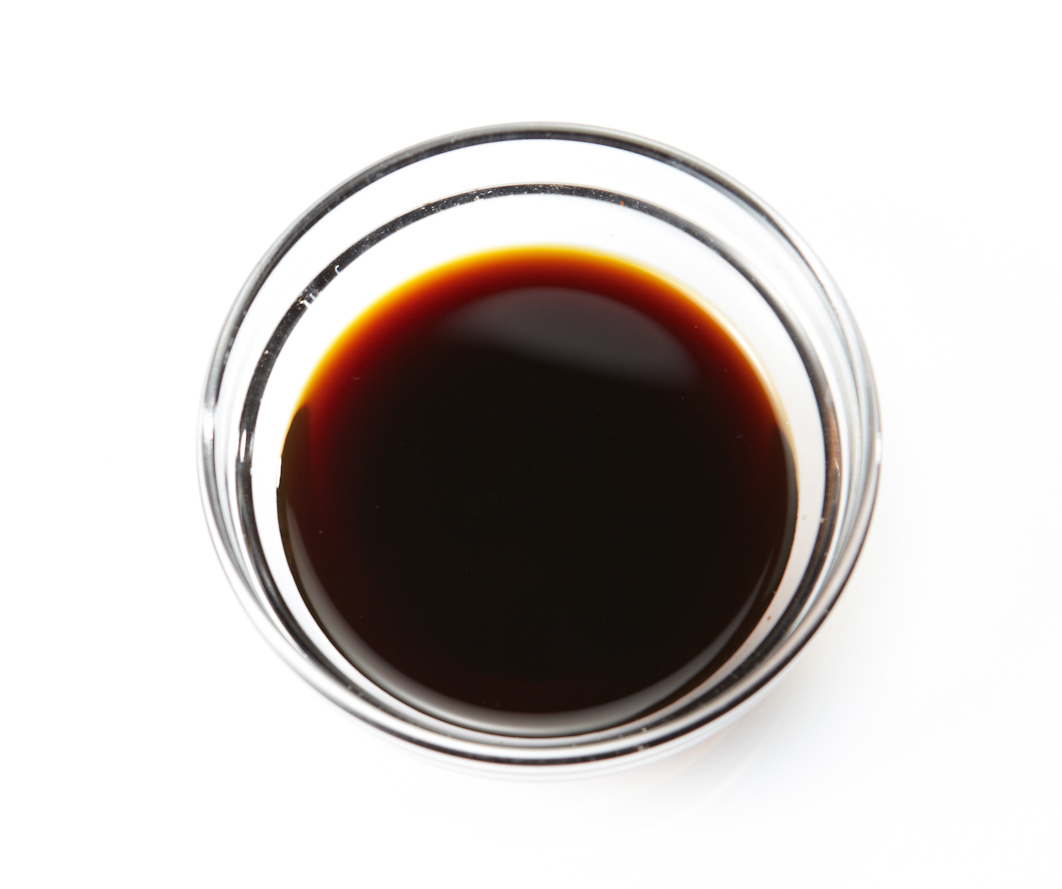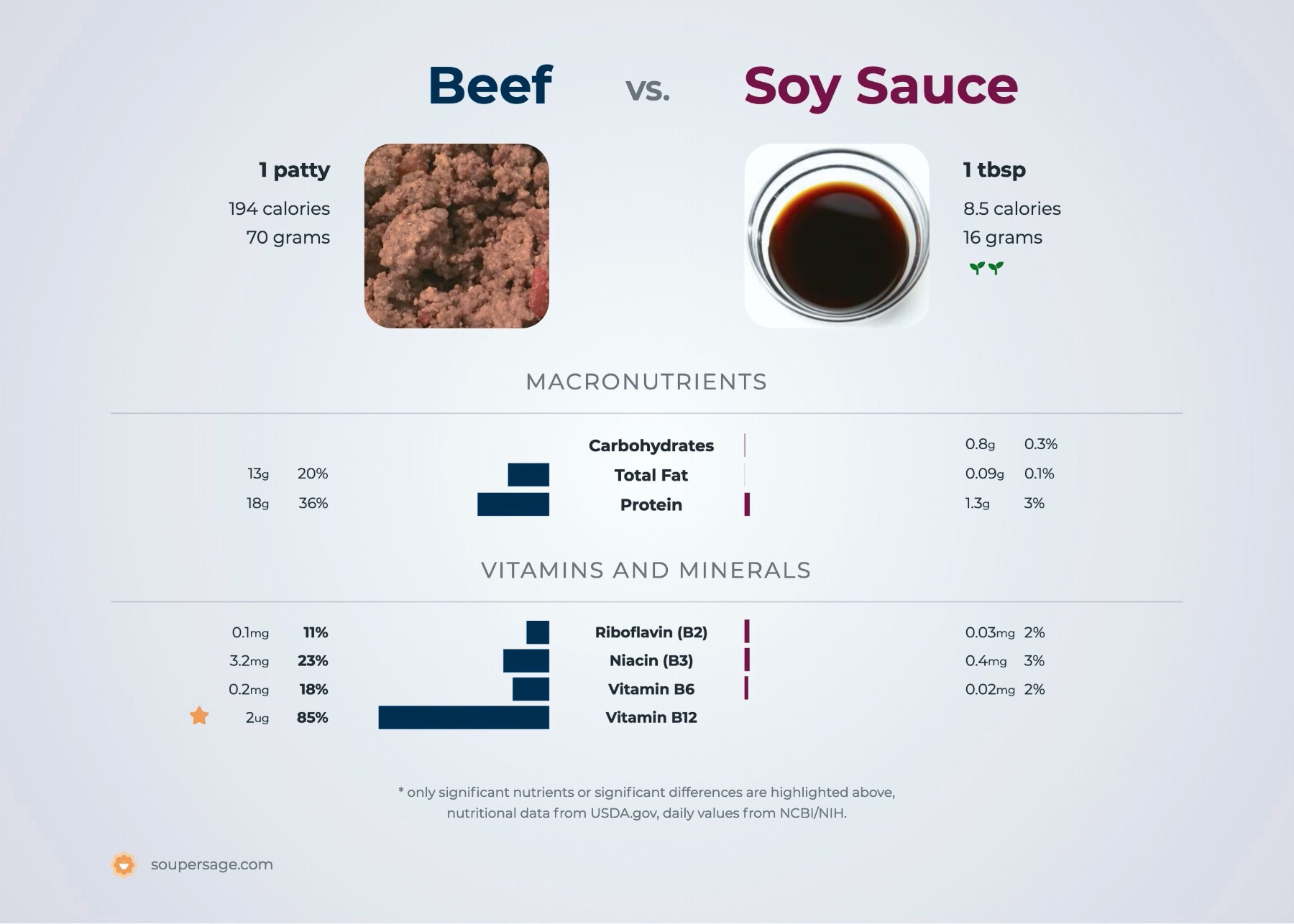Beef vs. Soy Sauce
Nutrition comparison of Cooked Beef and Soy Sauce
Ever wonder how your favorite foods stack up against each other in terms of nutrition?
We compared the nutritional contents of
cooked
beef
versus
soy sauce
(100g each)
below using 2020 USDA and NIH data[1].
For a quick recap of significant nutrients and differences in beef and soy sauce:
- Both beef and soy sauce are high in potassium and protein.
- Beef has more pantothenic acid, Vitamin B6 and Vitamin B12.
- Beef is a great source of iron.
USDA sources for nutritional information: Beef (Beef, ground, 70% lean meat / 30% fat, patty, cooked, broiled) and Soy Sauce (Soy sauce made from soy and wheat (shoyu)) . Have a correction or suggestions? Shoot us an email.
Calories and Carbs
calories
Beef is high in calories and soy sauce has 81% less calories than beef - beef has 277 calories per 100 grams and soy sauce has 53 calories.
For macronutrient ratios, beef is lighter in protein, much lighter in carbs and much heavier in fat compared to soy sauce per calorie. Beef has a macronutrient ratio of 38:0:62 and for soy sauce, 56:34:10 for protein, carbohydrates and fat from calories.
Macro Ratios from Calories:
| Beef | Soy Sauce | |
|---|---|---|
| Protein | 38% | 56% |
| Carbohydrates | ~ | 34% |
| Fat | 62% | 10% |
| Alcohol | ~ | ~ |
carbohydrates
Both soy sauce and beef are low in carbohydrates - soy sauce has 4.9g of total carbs per 100 grams and beef does not contain significant amounts.
dietary fiber
Soy sauce has more dietary fiber than beef - soy sauce has 0.8g of dietary fiber per 100 grams and beef does not contain significant amounts.
sugar
Soy sauce and beef contain similar amounts of sugar - soy sauce has 0.4g of sugar per 100 grams and beef does not contain significant amounts.
Protein
protein
Both beef and soy sauce are high in protein. Beef has 212% more protein than soy sauce - beef has 25.4g of protein per 100 grams and soy sauce has 8.1g of protein.
Fat
saturated fat
Beef is high in saturated fat and soy sauce has 99% less saturated fat than beef - beef has 7.3g of saturated fat per 100 grams and soy sauce has 0.07g of saturated fat.
trans fat
Soy sauce has less trans fat than beef - beef has 1.2g of trans fat per 100 grams and soy sauce does not contain significant amounts.
cholesterol
Soy sauce has less cholesterol than beef - beef has 88mg of cholesterol per 100 grams and soy sauce does not contain significant amounts.
Vitamins
Vitamin A
Beef and soy sauce contain similar amounts of Vitamin A - beef has 3ug of Vitamin A per 100 grams and soy sauce does not contain significant amounts.
Vitamin D
Beef and soy sauce contain similar amounts of Vitamin D - beef has 2iu of Vitamin D per 100 grams and soy sauce does not contain significant amounts.
Vitamin E
Beef and soy sauce contain similar amounts of Vitamin E - beef has 0.12mg of Vitamin E per 100 grams and soy sauce does not contain significant amounts.
Vitamin K
Beef and soy sauce contain similar amounts of Vitamin K - beef has 3ug of Vitamin K per 100 grams and soy sauce does not contain significant amounts.
The B Vitamins
Beef has more pantothenic acid, Vitamin B6 and Vitamin B12. Both beef and soy sauce contain significant amounts of thiamin, riboflavin, niacin and folate.
| Beef | Soy Sauce | |
|---|---|---|
| Thiamin | 0.051 MG | 0.033 MG |
| Riboflavin | 0.176 MG | 0.165 MG |
| Niacin | 4.537 MG | 2.196 MG |
| Pantothenic acid | 0.658 MG | 0.297 MG |
| Vitamin B6 | 0.336 MG | 0.148 MG |
| Folate | 11 UG | 14 UG |
| Vitamin B12 | 2.9 UG | ~ |
Minerals
calcium
Beef and soy sauce contain similar amounts of calcium - beef has 35mg of calcium per 100 grams and soy sauce has 33mg of calcium.
iron
Beef is a great source of iron and it has 55% more iron than soy sauce - beef has 2.3mg of iron per 100 grams and soy sauce has 1.5mg of iron.
potassium
Both beef and soy sauce are high in potassium. Soy sauce has 58% more potassium than beef - beef has 275mg of potassium per 100 grams and soy sauce has 435mg of potassium.
Omega-3 and Omega-6
omega 3s
For omega-3 fatty acids, both beef and soy sauce contain significant amounts of alpha linoleic acid (ALA).
| Beef | Soy Sauce | |
|---|---|---|
| alpha linoleic acid | 0.056 G | 0.029 G |
| Total | 0.056 G | 0.029 G |
omega 6s
Comparing omega-6 fatty acids, both beef and soy sauce contain significant amounts of linoleic acid.
| Beef | Soy Sauce | |
|---|---|---|
| other omega 6 | 0.012 G | ~ |
| linoleic acid | 0.39 G | 0.234 G |
| Total | 0.402 G | 0.234 G |
Customize your serving size
The comparison below is by common portions, e.g. cups, packages. You can also see a more concrete comparison by weight at equal weight (by grams) comparison.
Cooked Beef g
()
|
Daily Values (%) |
Soy Sauce g
()
|
|||||
|---|---|---|---|---|---|---|---|
| KCAL % |
|
5% | calories | 5% |
|
KCAL % | |
| G % |
|
5% | carbohydrates | 5% |
|
G % | |
| G % |
|
5% | dietary fiber | 5% |
|
G % | |
| G | 5% | sugar | 5% | G | |||
| G % |
|
5% | total fat | 5% |
|
G % | |
| G % |
|
5% | saturated fat | 5% |
|
G % | |
| G | 5% | monounsaturated fat | 5% | G | |||
| G | 5% | polyunsaturated fat | 5% | G | |||
| G | 5% | trans fat | 5% | G | |||
| MG | 5% | cholesterol | 5% | MG | |||
| MG % |
|
5% | sodium | 5% |
|
MG % | |
| 5% | Vitamins and Minerals | 5% | |||||
| UG % |
|
5% | Vitamin A | 5% |
|
UG % | |
| MG % |
|
5% | Vitamin C | 5% |
|
MG % | |
| IU % |
|
5% | Vitamin D | 5% |
|
IU % | |
| MG % |
|
5% | calcium | 5% |
|
MG % | |
| MG % |
|
5% | iron | 5% |
|
MG % | |
| MG % |
|
5% | magnesium | 5% |
|
MG % | |
| MG % |
|
5% | potassium | 5% |
|
MG % | |
| MG % |
|
5% | thiamin (Vit B1) | 5% |
|
MG % | |
| MG % |
|
5% | riboflavin (Vit B2) | 5% |
|
MG % | |
| MG % |
|
5% | niacin (Vit B3) | 5% |
|
MG % | |
| MG % |
|
5% | Vitamin B6 | 5% |
|
MG % | |
| MG % |
|
5% | pantothenic acid (Vit B5) | 5% |
|
MG % | |
| UG % |
|
5% | folate (Vit B9) | 5% |
|
UG % | |
| UG % |
|
5% | Vitamin B12 | 5% |
|
UG % | |
| MG % |
|
5% | Vitamin E | 5% |
|
MG % | |
| UG % |
|
5% | Vitamin K | 5% |
|
UG % | |
| G % |
|
5% | protein | 5% |
|
G % | |
| UG % |
|
5% | biotin (Vit B7) | 5% |
|
UG % | |
| MG % |
|
5% | choline | 5% |
|
MG % | |
| MG % |
|
5% | chlorine | 5% |
|
MG % | |
| UG % |
|
5% | chromium | 5% |
|
UG % | |
| MG % |
|
5% | copper | 5% |
|
MG % | |
| UG % |
|
5% | fluoride | 5% |
|
UG % | |
| UG % |
|
5% | iodine | 5% |
|
UG % | |
| MG % |
|
5% | manganese | 5% |
|
MG % | |
| UG % |
|
5% | molybdenum | 5% |
|
UG % | |
| MG % |
|
5% | phosphorus | 5% |
|
MG % | |
| UG % |
|
5% | selenium | 5% |
|
UG % | |
| MG % |
|
5% | zinc | 5% |
|
MG % | |
| G | 5% | Water | 5% | G | |||
| G | 5% | Starch | 5% | G | |||
| G | 5% | Alcohol | 5% | G | |||
FAQ
Does beef or soy sauce contain more calories in 100 grams?Beef is high in calories and soy sauce has 80% less calories than beef - beef has 277 calories in 100g and soy sauce has 53 calories.
Is beef or soy sauce better for protein?
Both beef and soy sauce are high in protein. Beef has 210% more protein than soy sauce - beef has 25.4g of protein per 100 grams and soy sauce has 8.1g of protein.
Does soy sauce or beef have more carbohydrates?
By weight, both soy sauce and beef are low in carbohydrates - soy sauce has 4.9g of carbs for 100g and beef has no carbs..
Does beef or soy sauce contain more potassium?
Both beef and soy sauce are high in potassium. Soy sauce has 60% more potassium than beef - beef has 275mg of potassium in 100 grams and soy sauce has 435mg of potassium.


